Loire
| Loire | |
|---|---|
Arpitan) | |
| Location | |
| Country | France |
| Physical characteristics | |
| Source | Massif Central |
| • location | Sainte-Eulalie, Ardèche |
| • coordinates | 44°49′48″N 4°13′20″E / 44.83000°N 4.22222°E |
| • elevation | 1,408 m (4,619 ft)[1] |
| Mouth | Atlantic Ocean |
• location | Saint-Nazaire, Loire-Atlantique |
• coordinates | 47°16′09″N 2°11′09″W / 47.26917°N 2.18583°W |
• elevation | 0 m (0 ft) |
| Length | 1,006 km (625 mi)[2] |
| Basin size | 117,000 km2 (45,000 sq mi)[1] |
| Discharge | |
| • location | Montjean-sur-Loire[3] |
| • average | 835.3 m3/s (29,500 cu ft/s)[3] |
| • minimum | 60 m3/s (2,100 cu ft/s) |
| • maximum | 4,150 m3/s (147,000 cu ft/s) |
| Basin features | |
| Tributaries | |
| • left | Allier, Cher, Indre, Vienne, Sèvre Nantaise |
| • right | Maine, Nièvre, Erdre |
The Loire Valley between Sully-sur-Loire and Chalonnes | |
| Criteria | Cultural: (i)(ii)(iv) |
| Reference | 933bis |
| Inscription | 2000 (24th Session) |
| Extensions | 2017 |
| Area | 86,021 ha (212,560 acres) |
| Buffer zone | 213,481 ha (527,520 acres) |
The Loire (.
It rises in the southeastern quarter of the French
The Loire gives its name to six departments:
The human history of the Loire river valley is thought by some to begin with the
The Loire Valley has been called the "Garden of France" and is studded with over a thousand
Etymology
The name "Loire" comes from
Liga comes from the Proto-Indo-European root *legʰ-, meaning "to lie, lay" as in the Welsh word Lleyg, and also which gave many words in English, such as to lie, to lay, ledge, law, etc.
Geography

The source of the river lies in the eastern
under Mont Gerbier de Jonc gives rise to multiple sources, three of them located at the foot of Mount have been highlighted as river sources. The three streams converge to form the Loire, which descends the valley south of Mount through the village of Sainte-Eulalie itself.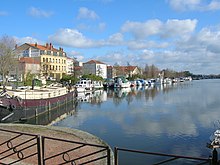
The Loire changed its course, due to tectonic deformations, from the original outfall into the English Channel to its new outfall into the Atlantic Ocean thereby forming today's narrow terrain of gorges, the Loire Valley with alluvium formations and the long stretch of beaches along the Atlantic Ocean.[1] The river can be divided into three main zones:[1]
- the Upper Loire, the area from the source to the confluence with the Allier
- the middle Loire Valley, the area from the Allier to the confluence with the Maine, about 280 km (170 mi)
- the Lower Loire, the area from Maine to the estuary
In the upper basin the river flows through a narrow, incised valley, marked by gorges and forests on the edges and a distinct low population.[1] In the intermediate section, the alluvial plain broadens and the river meanders and forks into multiple channels. River flow is particularly high in the river area near Roanne and Vichy up to the confluence with the Allier.[1] In the middle section of the river in the Loire Valley, numerous dikes built between the 12th and 19th century exist, providing mitigation against flooding. In this section the river is relatively straight, except for the area near Orléans, and numerous sand banks and islands exist.[1] The lower course of the river is characterized by wetlands and fens, which are of major importance to conservation, given that they form unique habitats for migratory birds.[1]

The Loire flows roughly northward through
- Ardèche
- Haute-Loire
- Loire
- Saône-et-Loire
- Allier
- Nièvre
- Cher
- Loiret
- Loir-et-Cher
- Indre-et-Loire
- Maine-et-Loire:
- Loire-Atlantique
The Loire Valley in the Loire river basin, is a 300 km (190 mi) stretch in the western reach of the river starting with Orléans and terminating at
Tributaries

Its main tributaries include the rivers
- Acheneau (in Le Pellerin)
- Sèvre Nantaise (in Nantes)
- Erdre (in Nantes)
- Èvre (in Le Marillais)
- Layon (in Chalonnes-sur-Loire)
- Maine (near Angers)
- Mayenne (near Angers)
- Oudon (in Le Lion-d'Angers)
- Ernée (in Saint-Jean-sur-Mayenne)
- Sarthe (near Angers)
- Loir (north of Angers)
- Pont-de-Braye)
- Aigre (near Cloyes-sur-le-Loir)
- Yerre (near Cloyes-sur-le-Loir)
- Conie (near Châteaudun)
- Ozanne (in Bonneval)
- Vaige (in Sablé-sur-Sarthe)
- Vègre (in Avoise)
- Huisne (in Le Mans)
- Loir (north of Angers)
- Mayenne (near Angers)
- Authion (in Sainte-Gemmes-sur-Loire)
- Thouet (near Saumur)
- Dive (near Saint-Just-sur-Dive)
- Losse (near Montreuil-Bellay)
- Argenton (near Saint-Martin-de-Sanzay)
- Taizé)
- Saint-Loup-sur-Thouet)
- Palais (near Parthenay)
- Viette (near Parthenay)
- Vienne (in Montsoreau and Candes-Saint-Martin)
- Creuse (north of Châtellerault)
- Gartempe (in La Roche-Posay)
- Petite Creuse (in Fresselines)
- Clain (in Châtellerault)
- Clouère (in Château-Larcher)
- Briance (in Condat-sur-Vienne)
- Taurion (in Saint-Priest-Taurion)
- Creuse (north of Châtellerault)
- Indre (east of Candes-Saint-Martin)
- Indrois (in Azay-sur-Indre)
- Cher (in Villandry)
- Sauldre (in Selles-sur-Cher)
- Rère (in Villeherviers)
- Arnon (near Vierzon)
- Yèvre (in Vierzon)
- Auron (in Bourges)
- Airain (in Savigny-en-Septaine)
- Tardes (in Évaux-les-Bains)
- Sauldre (in Selles-sur-Cher)
- Beuvron (in Chaumont-sur-Loire)
- Cosson (in Candé-sur-Beuvron)
- Loiret (in Orléans)
- Vauvise (in Saint-Satur)
- Allier (near Nevers)
- Sioule (in La Ferté-Hauterive)
- Dore (near Puy-Guillaume)
- Allagnon (near Jumeaux)
- Senouire (near Brioude)
- Ance (in Monistrol-d'Allier)
- Chapeauroux (in Saint-Christophe-d'Allier)
- Nièvre (in Nevers)
- Acolin (near Decize)
- Aron (in Decize)
- Alène (in Cercy-la-Tour)
- Besbre (near Dompierre-sur-Besbre)
- Arroux (in Digoin)
- Arconce (in Varenne-Saint-Germain)
- Lignon du Forez (in Feurs)
- Furan (in Andrézieux-Bouthéon)
- Ondaine (in Unieux)
- Lignon du Velay (in Monistrol-sur-Loire)
Geology
The geological formations in the Loire river basin can be grouped into two sets of formations, namely, the basement domain and the domain of sedimentary formations. The basement domain primarily consists of metamorphic and siliceous fragmented rocks with groundwater occurring in fissures. The sedimentary domain consists of limestone and carbonaceous rocks, that, where saturated, form productive aquifers. Rock outcrops of granite or basalt also are exposed in the river bed in several stretches.[11]
The middle stretches of the river have many limestone caves which were inhabited by humans in the prehistoric era; the caves are several types of limestone formations, namely tuffeau (a porous type of chalk, not to be confused with tufa) and Falun (formed 12 million years ago). The coastal zone shows hard dark stones, granite, schist and thick soil mantle.[10]
Discharge and flood regulation


The river has a discharge rate of 863 m3/s (30,500 cu ft/s), which is an average over the period 1967–2008.[1] The discharge rate varies strongly along the river, with roughly 350 m3/s (12,000 cu ft/s) at Orléans and 900 m3/s (32,000 cu ft/s) at the mouth. It also depends strongly on the season, and the flow of only 10 m3/s (350 cu ft/s) is not uncommon in August–September near Orléans. During floods, which usually occur in February and March[12] but also in other periods,[4] the flow sometimes exceeds 2,000 m3/s (71,000 cu ft/s) for the Upper Loire and 8,000 m3/s (280,000 cu ft/s) in the Lower Loire.[12] The most serious floods occurred in 1856, 1866 and 1911. Unlike most other rivers in western Europe, there are very few dams or locks creating obstacles to its natural flow. The flow is no longer partly regulated by three dams: Grangent Dam and Villerest Dam on the Loire and Naussac Dam on the Allier. The Villerest dam, built in 1985 a few kilometres (a few miles) south of Roanne,[13] has played a key-role in preventing recent flooding. As a result, the Loire is a very popular river for boating excursions, flowing through a pastoral countryside, past limestone cliffs and historic castles. Four nuclear power plants are located on the river: Belleville, Chinon, Dampierre and Saint-Laurent.
In 1700 the port of Nantes numbered more inland waterway craft than any other port in France, testifying to the historic importance of navigation on France's longest river. Shallow-draught gabares and other river craft continued to transport goods into the industrial era, including coal from Saint-Étienne loaded on to barges in Orléans. However, the hazardous free-flow navigation and limited tonnages meant that railways rapidly killed off the surviving traffic from the 1850s. In 1894 a company was set up to promote improvements to the navigation from Nantes to Briare. The works were authorised in 1904 and carried out in two phases from Angers to the limit of tides at Oudon. These works, with groynes and submersible embankments, survive and contribute to the limited navigability under present-day conditions.[14] A dam across the Loire at Saint-Léger-des-Vignes provides navigable conditions to cross from the Canal du Nivernais to the Canal latéral à la Loire.
As of 2017[update], the following sections are navigable:
- Loire maritime: 53 km from the Atlantic Ocean at Saint-Nazaire to Nantes, no locks[15]
- Loire: 84 km from Nantes to Bouchemaine near Angers, no locks[16]
- Canal latéral à la Loire: 196 km from Briare to Digoin, parallel to the river, 36 locks[17]
- Canal de Roanne à Digoin: 56 km from Digoin to Roanne, parallel to the river, 10 locks[18]
Climate
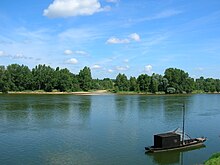
The French language adjective ligérien is derived from the name of the Loire, as in le climat ligérien ("the climate of the Loire Valley"). The climate is considered the most pleasant of northern France, with warmer winters and, more generally, fewer extremes in temperatures, rarely exceeding 38 °C (100 °F). It is identified as temperate maritime climate, and is characterised by the lack of dry seasons and by heavy rains and snowfall in winter, especially in the upper streams.[4] The number of sunny hours per year varies between 1400 and 2200 and increases from northwest to southeast.[1]
The Loire Valley, in particular, enjoys a pleasant temperate climate. The region experiences a rainfall of 690 mm (27.2 in) along the coast and 648 mm (25.5 in) inland.[10]
Flora

The Centre region of the Loire river valley accounts for the largest forest in France, the
Wildlife
The river flows through the continental ecoregions of
Plankton
With more than 100
Fish
Nearly every freshwater fish species of France can be found in the Loire river basin, that is, about 57 species from 20 families. Many of them are migratory, with 11 species ascending the river for spawning. The most common species are the
Although only one native fish species has become extinct in the Loire, namely the European sea sturgeon (Acipenser sturio) in the 1940s, the fish population is declining, mostly due to the decrease in the spawning areas. The latter are mostly affected by the industrial pollution, construction of dams and drainage of oxbows and swamps. The loss of spawning grounds mostly affects the pike (Esox lucius), which is the major predator of the Loire, as well as eel, carp, rudd and salmon. The great Loire salmon, a subspecies of Atlantic salmon, is regarded as the symbolic fish of the river. Its population has decreased from about 100,000 in the 19th century to below 100 in the 1990s that resulted in the adoption of a total ban of salmon fishing in the Loire basin in 1984. A salmon restoration program was initiated in the 1980s and included such as measures as removal of two obsolete hydroelectric dams and introduction of juvenile stock. As a result, the salmon population increased to about 500 in 2005.[1]
Amphibians

Most amphibians of the Loire are found in the slow flow areas near the delta, especially in the floodplain, marshes and oxbows. They are dominated by the
Avifauna

The Loire hosts about 64% of nesting bird species of France, that is 164 species, of which 54 are water birds, 44 species are common for managed forests, 41 to natural forests, 13 to open and 12 to rocky areas. This avifauna has been rather stable, at least between the 1980s and 2000s, with significant abundance variations observed only for 17 species. Of those, five species were growing in population, four declining, and other eight were fluctuating. Some of these variations had a global nature, such as the expansion of the Mediterranean gull in Europe.[1]
Conservation
The Loire has been described as "constantly under threat of losing its status as the last wild river in France".

In 1986, the

The WWF were particularly important in changing the perception of the French authorities in support for dam building to environmental protection and sustainable management of its river basin.[22] In 1992, they aided the ‘Loire Nature’ project, which received funds of some $US 9 million under the EU's ‘LIFE’ programme until 1999, embarking upon restoration to the river's ecosystems and wildlife.[22] That year, the Upper Loire Valley Farmers Association was also established through a partnership between SOS Loire Vivante and a farmers’ union to promote sustainable rural tourism.[22] The French government adopted the Natural Loire River Plan (Plan Loire Grandeur Nature) in January 1994, initiating the decommissioning of three dams on the river.[23] The final dam was decommissioned by Électricité de France at a cost of 7 million francs in 1998.[23] The basis of the decision was that the economic benefits of the dams did not outweigh their significant ecological impacts, so the intention was to restore the riverine ecosystems and replenish great Loire salmon stocks.[23] The Loire is unique in this respect as the Atlantic salmon can swim as far as 900 km (560 mi) up the river and spawn in the upper reaches of the Allier. The French government undertook this major plan, chiefly because pollution and overfishing had reduced approximately 100,000 salmon migrating annually to their spawning grounds in the headwaters of the Loire and its tributaries to just 67 salmon in 1996 on the upper Allier.[22]
The WWF, BirdLife International, and local conservation bodies have also made considerable efforts to improve the conservation of the Loire estuary and its surroundings, given that they are unique habitats for migrating birds. The estuary and its shoreline are also important for fishing, shellfish farming and tourism. The major commercial port at Nantes has caused severe damage to the ecosystem of the Loire estuary.[22] In 2002, the WWF aided a second Loire Nature project and expanded its scope to the entire basin, addressing some 4,500 hectares (11,000 acres) of land under a budget of
History

Prehistoric period
Studies of the palaeo-geography of the region suggest that the palaeo-Loire flowed northward and joined the Seine,[24][25] while the lower Loire found its source upstream of Orléans in the region of Gien, flowing westward along the present course. At a certain point during the long history of uplift in the Paris Basin, the lower, Atlantic Loire captured the "palaeo-Loire" or Loire séquanaise ("Seine Loire"), producing the present river. The former bed of the Loire séquanaise is occupied by the Loing.
The Loire Valley has been inhabited since the Middle Palaeolithic period from 40–90
to the Loire to get from the Mediterranean basin to the Atlantic coast.Ancient Rome, Alans and the Vikings

The
In the 5th century, the Roman Empire declined and the Franks and the Alemanni came to the area from the east. Following this there was ongoing conflict between the Franks and the Visigoths.[27] In 408, the Iranian tribe of Alans crossed the Loire and large hordes of them settled along the middle course of the Loire in Gaul under King Sangiban.[28] Many inhabitants around the present city of Orléans have names bearing witness to the Alan presence – Allaines.
In the 9th century, the
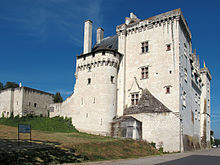
Medieval period
During the Hundred Years' War from 1337 to 1453, the Loire marked the border between the French and the English, who occupied territory to the north. One-third of the inhabitants died in the epidemic of the Black Death of 1348–9.[29] The English defeated the French in 1356 and Aquitaine came under English control in 1360. In 1429, Joan of Arc persuaded Charles VII to drive out the English from the country.[30] Her successful relief of the siege of Orléans, on the Loire, was the turning point of the war.

In 1477, the first
In the 1530s, the
1600–present

For centuries local people used wooden embankments and dredging to try to maintain a navigable channel on the river, as it was critical to transportation. River traffic increased gradually, with a toll system being used in medieval times. Today some of these toll bridges still remain, dated to over 800 years.[37] During the 17th century, Jean-Baptiste Colbert instituted the use of stone retaining walls and quays from Roanne to Nantes, which helped make the river more reliable,[38] but navigation was still frequently stopped by excessive conditions during flood and drought. In 1707, floods were said to have drowned 50,000 people in the river valley,[39] with the water rising more than 3 m (9.8 ft) in two hours in Orléans. Typically passenger travel downriver from Orléans to Nantes took eight days, with the upstream journey against the flow taking fourteen. It was also a dumping ground for prisoners in the War in the Vendée since they thought it was a more effective way of killing.
Soon after the beginning of the 19th century, steam-driven passenger boats began to ply the river between Nantes and Orléans, making the upriver journey faster; by 1843, 70,000 passengers were being carried annually in the Lower Loire and 37,000 in the Upper Loire.[40] But competition from the railway, beginning in the 1840s, caused a decline in trade on the river. Proposals to develop a fully navigable river up to Briare came to nothing. The opening of the Canal latéral à la Loire in 1838 enabled navigation between Digoin and Briare to continue,[41] but the river level crossing at Briare remained a problem until the construction of the Briare aqueduct in 1896. At 662.69 metres (2,174.2 ft), this was the longest such structure in the world for quite some time.[41]
The Canal de Roanne à Digoin was also opened in 1838. It was nearly closed in 1971 but, in the early 21st century, it still provides navigation further up the Loire valley to Digoin.[41][42] The 261 km (162 mi) Canal de Berry, a narrow canal with locks only 2.7 m (8.9 ft) wide, which was opened in the 1820s and connected the Canal latéral à la Loire at Marseilles-lès-Aubigny to the river Cher at Noyers and back into the Loire near Tours, was closed in 1955.
The river is officially navigable as far as Bouchemaine,[43] where the Maine joins it near Angers. Another short stretch much further upstream at Decize is also navigable, where a river level crossing from the Canal latéral à la Loire connects to the Canal du Nivernais.
In 2022, a drought rendered parts of the Loire unnavigable for fish and water vessels as they were partially or completely dried up.[44]
Timeline
The monarchy of France ruled in the Loire Valley for several centuries, giving it the name of "The Valley of Kings". These rulers started with the Gauls, followed by the Romans, and the
| Ruler | Period of reign | Remarks |
|---|---|---|
| Gauls | 1500–500 BC | Iron Age. Settled in Cenabum (Orléans) and Arabou. Trading along the Loire |
| Romans | 52 BC-5th century | Spread of Benedictine Order prospered.
|
Frankish Dynasty and feudal lords
|
5th–10th centuries | Power struggles among feudal states. city. |
Jean II
|
1350–1364 | Was defeated by England. Ceded territory to the English Crown
|
| Charles VI | 1380–1422 | Ruled during the peak of Hundred Years' War. Was known as the mad king or ‘le fou’. Married his daughter to Henry V, the King of England, and who was also declared heir to the throne of France. |
| Charles VII | 1422–1461 | He was helped by the famous Joan of Arc to ascend the throne of France and ruled from Chinon. He also had an officially recognized mistress named Agnès Sorel. |
Louis XI
|
1461–1483 | An authoritarian ruler, reigned from Amboise, and had two queens |
| Charles VIII | 1483–1498 | He had strange marriages, including Anne, a four-year-old bride who married the heir of Charles VIII after his death. |
Louis XII
|
1498–1515 | Married widow Anne de Bretagne after divorcing Jeanne de Valois. Anne ruled from Blois till her death in 1514. Louis died in 1515
|
| François I | 1515–1547 | Second cousin of Louis XII. Activity centred at Amboise. Literary and architectural attainments. Influence of Renaissance architecture and scientific ideas. Secular ideas prevailed over religious ethos. Leonardo da Vinci was patronized who settled in Amboise in 1516. Captured in the war in 1525 with the Italians. |
Wars of Religion
|
1530–1572 | Internecine fights and killings among the Protestants and Catholic Monarchy
|
| Henri III | 1574–1589 | Fled from Louvre. Took refuge in Tours and eventually killed by a monk |
| Henri IV | 1553–1610 | First King of Bourbon dynasty, Adopted the Catholic faith, Decreed the Edict of Nantes. Saumur was established as a prominent academic centre. |
Louis XIII
|
1610– | Importance of Loire valley declined |
| French Revolution | 1789 onwards | Decline of monarchy or rule of Kings. Many châteaux of Loire valley destroyed and many converted into prisons and schools. Reign of terror between 1793 and 1794 saw killing of counter revolutionaries by sinking ships carrying them forcibly in the Loire. |
Loire Valley

The
On December 2, 2000,
Architecture
Architectural edifices were created in Loire valley from the 10th century onwards with the defensive fortress like structures called the "
This style was replaced by the religious architectural style in the 12th to 14th centuries when the impregnable château fortresses were built on top of rocky hills; one of the impressive fortresses of this type is the
The
The
The French Revolution (1789) brought a radical change for the worse in the scenarios for chateaus, as monarchy ended in France.[49]
Châteaux
The
-
Amboise on the banks of the Loire
-
Chateau de Langeais
-
(from right to left).
Wine making


The Loire Valley wine region includes the
The Loire Valley has a long history of
The Loire river has a significant effect on the
The Loire Valley has a high density of vine plantings with an average of 4,000–5,000 vines per hectare (1,600–2,000 per acre). Some Sancerre vineyards have as many as 10,000 plants per hectare. With more vines competing for the same limited resources in the soil, the density is designed to compensate for the excessive
The Loire Valley is often divided into three sections. The Upper Loire includes the Sauvignon blanc dominated areas of
The area includes 87
Art
The Loire has inspired many poets and writers, including: Charles d'Orléans, François Rabelais, René Guy Cadou, Clément Marot, Pierre de Ronsard, Joachim du Bellay, Jean de La Fontaine, Charles Péguy, Gaston Couté; and painters such as: Raoul Dufy, J. M. W. Turner, Gustave Courbet, Auguste Rodin, Félix Edouard Vallotton, Jacques Villon, Jean-Max Albert, Charles Leduc, Edmond Bertreux, and Jean Chabot.
-
Scène of the Loire, by J. M. W. Turner.
-
La source de la Loire, by Gustave Courbet.
-
Portrait of the Loire, by Jean-Max Albert, 1988. Musée de la Loire, Cosne-sur-Loire.
-
Les Rosiers-sur-Loire by Jean-Jacques Delusse, 1800
See also
- Rivers of France
- Pays de la Loire region
References
- ^ ISBN 978-0-12-369449-2. Retrieved 11 April 2011.
- ^ .
- ^ a b "The Loire at Montjean". River Discharge Database. Center for Sustainability and the Global Environment. 2010-02-13. Archived from the original on 2011-09-28. Retrieved 2011-06-30.
- ^ a b c d e "The Loire". Encyclopædia Britannica online.
- ^ ISBN 978-1-86450-358-6. Retrieved 13 April 2011.
- ^ "Welcome to the Loire Valley". Western France Tourist Board. Retrieved 13 April 2011.
- ^ a b "The Loire Valley" (PDF). Lonely Planet. Archived from the original (PDF) on 15 October 2012. Retrieved 11 March 2011.
- ISBN 978-3-89508-598-7. Retrieved 11 April 2011.
- ISBN 978-1-86011-357-4. Retrieved 11 April 2011.
- ^ a b c Williams & Boone, p. 33
- ISBN 978-0-12-369449-2. Retrieved 11 April 2011.
- ^ a b "Луара (река во Франции)". Great Soviet Encyclopedia (in Russian).
- ^ New scientist. IPC Magazines. 1991. p. 46. Retrieved 11 April 2011.
- ISBN 978-1-846230-14-1.
- ^ Fluviacarte, Loire (maritime)
- ^ Fluviacarte, Loire
- ^ Fluviacarte, Canal latéral à la Loire
- ^ Fluviacarte, Canal de Roanne à Digoin
- ^ Williams & Boone, p. 35-36
- ^ ISBN 978-0-471-96062-1. Retrieved 24 April 2011.
- ^ IUCN bulletin. International Union for Conservation of Nature and Natural Resources. 1989. p. 9. Retrieved 24 April 2011.
- ^ World Wildlife Fund. Retrieved 24 April 2011.
- ^ ISBN 978-2-8317-0575-0. Retrieved 24 April 2011.
- ^ Tourenq, J.; Pomerol, C. (1995). "Mise en évidence, par la présence d'augite du Massif Central, de l'existence d'une pré-Loire-pré-Seine coulant vers la Manche". Comptes Rendus de l'Académie des Sciences. 320: 1163–1169.
- .
- ^ a b c d e f g Williams & Boone, p.11
- ^ a b Williams & Boone, p.12
- ^ Abaev, V. I.; Bailey, H. W. "Alans". Encyclopædia Iranica. Vol. I/8. pp. 801–803.
- ^ a b Williams & Boone, p. 14
- ISBN 978-0-203-64466-9. Retrieved 11 April 2011.
- ^ a b c Williams & Boone, p.16
- ISBN 978-88-476-1840-4. Retrieved 11 April 2011.
- ISBN 978-1-85669-371-4. Retrieved 11 April 2011.
- ISBN 978-1-145-42193-6. Retrieved 11 April 2011.
- ISBN 978-1-57607-155-7. Retrieved 11 April 2011.
- ISBN 978-0-8028-3860-5. Retrieved 11 April 2011.
- ISBN 978-1-85058-772-9. Retrieved 11 April 2011.
- ISBN 978-0-8057-7715-4. Retrieved 11 April 2011.
- ISBN 978-0-444-88824-2. Retrieved 11 April 2011.
- ISBN 978-0-06-092142-2. Retrieved 11 April 2011.
- ^ ISBN 978-1-57409-210-3. Retrieved 11 April 2011.
- ^ Institut des études rhodaniennes (1971). Revue de géographie de Lyon. Université de Lyon. Retrieved 11 April 2011.
- ISBN 978-0-540-07140-1. Retrieved 11 April 2011.
- ^ Mahe, Stephane (17 August 2022). "France's river Loire sets new lows as drought dries up its tributaries". Loireauxence: Reuters. Archived from the original on 18 August 2022. Retrieved 20 August 2022.
- ^ Williams & Boone, p.10
- ^ a b c Williams & Boone, p. 19
- ^ Williams & Boone, p. 17
- ^ Williams & Boone, pp. 22–26
- ^ Williams & Boone, p. 28
- ^ ISBN 0-19-860990-6
- ISBN 1-56305-434-5.
- ^ ISBN 1-74048-050-3.
- ISBN 0-7892-0883-0.
- ISBN 0-7566-1324-8.
Bibliography
- Williams, Nicola; Boone, Virginie (1 May 2002), The Loire, Lonely Planet, ISBN 978-1-86450-358-6
- Garrett, Martin, The Loire: a Cultural History. 2010, Signal Books. [ISBN missing]
- Pays de la Loire, waterways guide No. 10, Editions du Breil. pp 8–27, for the navigable section (guide in English, French and German)[ISBN missing]
External links
- River Loire guide, places, ports and moorings on the river in the navigable length from the Maine to Saint-Nazaire, by the author of Inland Waterways of France, Imray.
- Navigation details for 80 French rivers and canals (French waterways website section)
- (in English) Tourist Office Board Loire Valley
- (in English) Waterways In Western Loire – Free Online Travel Brochure


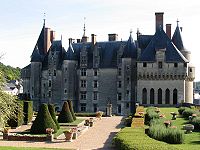



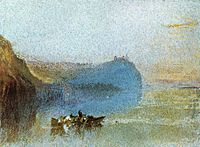
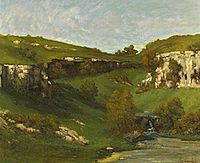
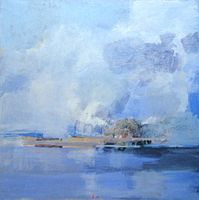
![Les Rosiers-sur-Loire by Jean-Jacques Delusse [fr], 1800](http://upload.wikimedia.org/wikipedia/commons/thumb/7/7e/Jean-Jacques_Delusse%2C_vue_des_Rosiers%2C_1800.jpg/200px-Jean-Jacques_Delusse%2C_vue_des_Rosiers%2C_1800.jpg)
